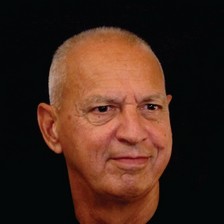
Vladimir Tošić (Belgrade, 1949), composer, multimedia artist, full professor at the Faculty of Music in Belgrade. Tošić completed his composition studies in the class of Vasilije Mokranjac at the same faculty in Belgrade. His works are regularly performed on concert stages and at festivals in Serbia and abroad: in Argentina, Austria, Belgium, Brazil, England, France, Holland, Italy, Germany, Peru, Portugal, USA, Scotland, Spain, Sweden… His pieces are found of a number of CD releases made in Serbia and the US. They include two single-author CDs: Muzika za klavir (Piano Music; FMU/SOKOJ, 2014) and Melange (PGP RTS, 2000). His work Voxal won the first prize at the Thomas Bloch Competition (Paris, 2000). Tošić also won the third prize at the 2011 Gitarrentage für Kinder, the competition of guitar music for children held in Lebach, Germany, and the awarded piece was published by Chanterelle, a renowned publishing house based in Heidelberg.
The basis of Vladimir Tošić’s creative approach is informed by the reductionist principle of music construction. All of his pieces are processual, repetitive, and based on a rather small number of different elements, sometimes even just one (colour, rhythm, harmony…). His most important works include Varial, Dual, Trial, Voxal, Fisija (Fission), Fuzija (Fusion), Altus, and Medial, among others.
Rondo for violin, clarinet, and piano (2011) was originally written for symphony orchestra but, like many other pieces in my oeuvre, exists in several more versions, for different kinds of ensembles. It just so happens that this version, for violin, clarinet, and piano, dedicated to the trio Pokret (Movement) will be the first to have a live performance (although the symphonic version was recorded by Bojan Suđić with the RTS Symphony Orchestra in December 2013).
As the title itself clearly indicates, the work’s formal structure is that of a rondo and this was the very first time I used a historical form for one of my works. The reason was my impression that the rondo has close correspondences with minimalist music. The rondo form is based on multiple repetitions of the opening material and is thus naturally suited to my work in composition thus far. Of course, it includes all the principal features of my work so far: the piece is extremely repetitive and processual, and its thematic materials comprise models based on the harmonic mode.
Its main thematic material – an eight-bar model – is dominated by lively movement, achieved through a dialogue between the violin and the clarinet, which changes through sequential repetition and ascends all the way to culmination. The model’s melody is constructed on the basis of a freely treated melodic series comprising the harmonic mode. The rondo’s remaining two sets of material are constructed in a rather similar fashion, by repeating the model within a dialogue between two instruments. Essentially, the entire piece rests on just two basic lines – bass and soprano – engaged in mutual dialogue.


